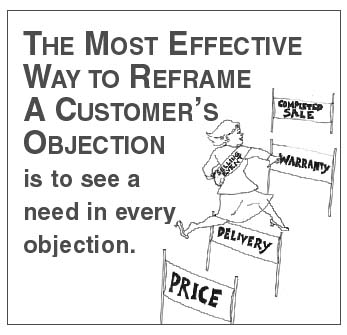The technique of reframing objections

For years psychologists have been telling us that perception is reality. That being true, each of us is capable of creating his or her own reality, and in the process of doing so, of having to live with consequences of whatever we create. How we perceive our world will surely affect our behavior, positively or negatively.
A thirsty person who perceives a glass of water as half full does so from the positive perspective of fullness. A thirsty person who perceives that same glass as half empty perceives it from the negative perspective of emptiness. But what faculty in our psyche causes one person to see things positively, another to see things negatively? Not being a psychologist, I won’t venture to give a psychological explanation of this phenomenon. Instead, I’ll give an explanation based upon my earliest childhood observations reaching into the present. I have long observed that some individuals appear to have developed a knack for reframing situations. Those of us that have sold pictures in furniture stores know that the frame can make all the difference in a customer’s decision to buy a given picture or not. The same picture in one frame can look attractive, in another frame unattractive. The same holds true for eyeglasses. It is amazing how one pair of glasses can give a person’s face a look quite different from that which another pair can give.
How salespeople frame a customer’s objections largely determines whether they will see them as roadblocks to be blasted out or as steppingstones to assist their progress. Positive minded salespeople reframe objections: they never think of them as something to be overcome, but simply as something to come over. They think like high hurdle runners: objections are just part of the event of selling. Every objection they come over takes them closer to the finishing line. Negative minded salespeople repeatedly think of objections merely as hurdles: if they cannot get over them, they’ll simply knock them down. Therefore, they knock down a lot of these hurdles on the way to the finishing line rather than clearing them; consequently they tend not to end up as winners.
The most effective way to reframe a customer’s objection, I believe, is not only to find something in it to agree with – a technique the Dale Carnegie sales seminars has been successfully teaching for years – but to take that technique one notch higher: to see a customer’s need in every customer objection. In other words, we can take our cue from the distinction between implying and inferring. Years ago in English 101 college students were taught that the speaker or writer implies something; the audience or reader infers what is implied. Applying that same distinction to objections, we can infer every objection as an implied need, that is, we can reframe it. Let’s take a look at how we can infer, that is, reframe the implied need in each objection in the following scenarios
Scenario One
Customer: You don’t buy a new leather sectional every other day, you know.
Salesperson: What I hear you saying is that you want to make sure you buy the kind of sectional you’re looking for, right?
Customer: You got that right. I’m afraid the leather won’t hold up and this is also a very expensive decision.
Salesperson: And it’ll be a very costly one if it turns out to be the wrong one. Mind if we go over why I believe this set is going to be the right one for you?
Scenario two
Customer: I’d like to take the more expensive mattress but I don’t think I can afford it.
Salesperson: It is important to stay on an affordable budget and it is also important to buy the mattress that gives you the kind of comfort you told me earlier you are looking for. Let’s talk about that.
Scenario three
Customer: We just have to have this dining room set in time for my parents’ 25th wedding anniversary. We are throwing a big party for them.
Salesperson: I can understand why having the dining room set on time is important to you, especially since you mentioned earlier your parents are coming in from Mississippi, and the rest of the family will be there too. Do look at the total picture. How do you think you are going to feel once that anniversary has passed, if you buy that second choice you saw elsewhere? Keep in mind that a dining room set this elegant is something you’ll want to enjoy for many years.
Note that the salesperson uses the words "the total picture" and not "the bigger picture. To imply that the parents’ 25th wedding anniversary is not the bigger picture would have been offensive to the couple at that point. Given the strong emotions surrounding that anniversary, the anniversary certainly appears as the bigger picture.
Reframing objections is a technique that goes hand in hand with side by side buying. By learning to infer the need in every objection, the salesperson joins sides with the customer. Reframing helps to win customers over by creating empathy and building rapport.
Corporate trainer, educator and speaker Dr. Peter A. Marino has written extensively on sales training techniques and their furniture retailing applications. Questions on any aspect of sales education can be sent to FURNITURE WORLD at pmarino@furninfo.com.